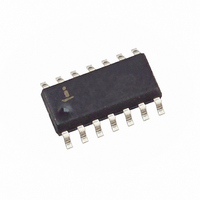EL5451IS Intersil, EL5451IS Datasheet - Page 11

EL5451IS
Manufacturer Part Number
EL5451IS
Description
IC AMP 200MHZ V-FB 14-SOIC
Manufacturer
Intersil
Datasheet
1.EL5451IS.pdf
(18 pages)
Specifications of EL5451IS
Amplifier Type
Voltage Feedback
Number Of Circuits
4
Slew Rate
100 V/µs
Gain Bandwidth Product
40MHz
-3db Bandwidth
200MHz
Current - Input Bias
20nA
Voltage - Input Offset
500µV
Current - Supply
1.35mA
Current - Output / Channel
70mA
Voltage - Supply, Single/dual (±)
5 V ~ 12 V, ±2.5 V ~ 6 V
Operating Temperature
-40°C ~ 85°C
Mounting Type
Surface Mount
Package / Case
14-SOIC (3.9mm Width), 14-SOL
Lead Free Status / RoHS Status
Contains lead / RoHS non-compliant
Output Type
-
Available stocks
Company
Part Number
Manufacturer
Quantity
Price
Company:
Part Number:
EL5451IS
Manufacturer:
Intersil
Quantity:
165
Typical Performance Curves
Product Description
The EL5150, EL5151, EL5250, EL5251 and EL5451 are
wide bandwidth, low power, low offset voltage feedback
operational amplifiers capable of operating from a single or
dual power supplies. This family of operational amplifiers are
internally compensated for closed loop gain of +1 or greater.
Connected in voltage follower mode, driving a 500Ω load
members of this amplifier family demonstrate a -3dB
bandwidth of about 200MHz. With the loading set to
accommodate typical video application, 150Ω load and gain
set to +2, bandwidth reduces to about 40MHz with a 67V/µs
slew rate. Power down pins on the EL5151 and EL5251
reduce the already low power demands of this amplifier
family to 12µA typical while the amplifier is disabled.
Input, Output and Supply Voltage Range
The EL5150 and family members have been designed to
operate with supply voltage ranging from 5V to 12V. Supply
voltages range from ±2.5V to ±5V for split supply operation.
And of course split supply operation can easily be achieved
using single supplies with by splitting off half of the single
supply with a simple voltage divider as illustrated in the
application circuit section.
Input Common Mode Range
These amplifiers have an input common mode voltage
ranging from 3.5V above the negative supply (V
3.5V below the positive supply (V
driven beyond this range the output signal will exhibit
distortion.
Maximum Output Swing & Load Resistance
The outputs of the EL5150 and family members exhibit
maximum output swing ranges from -4V to 4V for V
with a load resistance of 500Ω. Naturally, as the load
resistance becomes lower, the output swing lowers
FIGURE 39. PACKAGE POWER DISSIPATION vs AMBIENT
1.4
1.2
1.0
0.8
0.6
0.4
0.2
0
0
JEDEC JESD51-7 HIGH EFFECTIVE THERMAL
CONDUCTIVITY TEST BOARD
909mW
870mW
435mW
1.136W
TEMPERATURE
θ
JA
SOT23-5/6
25
= 230°C/W
AMBIENT TEMPERATURE (°C)
θ
50
JA
SO14
= 88°C/W
11
75 85
S
θ
+ pin). If the input signal is
JA
EL5150, EL5151, EL5250, EL5251, EL5451
= 110°C/W
SO8
100
θ
JA
MSOP8/10
= 115°C/W
(Continued)
125
S
- pin) to
S
150
= ±5V
accordingly; for instance, if the load resistor is 150Ω, the
output swing ranges from -3.5V to 3.5V. This response is a
simple application of Ohms law indicating a lower value
resistance results in greater current demands of the
amplifier. Additionally, the load resistance affects the
frequency response of this family as well as all operational
amplifiers; as clearly indicated by the Gain vs Frequency For
Various R
frequency response reduced bandwidth with decreasing
load resistance is a function of load resistance in conjunction
with the output zero response of the amplifier.
Choosing A Feedback Resistor
A feedback resistor is required to achieve unity gain; simply
short the output pin to the inverting input pin. Gains greater
than +1 require a feedback and gain resistor to set the
desired gain. This gets interesting because the feedback
resistor forms a pole with the parasitic capacitance at the
inverting input; as the feedback resistance increases the
position of the pole shifts in the frequency domain, the
amplifier's phase margin is reduced and the amplifier
becomes less stable. Peaking in the frequency domain and
ringing in the time domain are symptomatic of this shift in
pole location. So we want to keep the feedback resistor as
small as possible. You may want to use a large feedback
resistor for some reason; in this case to compensate the shift
of the pole and maintain stability a small capacitor in the few
Pico farad range in parallel with the feedback resistor is
recommended.
For the gains greater than unity it has been determined a
feedback resistance ranging from 500Ω to 750Ω provides
optimal response.
FIGURE 40. PACKAGE POWER DISSIPATION vs AMBIENT
0.9
0.8
0.7
0.6
0.5
0.4
0.3
0.2
0.1
L
1
0
curves clearly indicate. In the case of the
0
JEDEC JESD51-3 LOW EFFECTIVE THERMAL
CONDUCTIVITY TEST BOARD
833mW
625mW
486mW
391mW
TEMPERATURE
θ
JA
SOT23-5/6
25
= 265°C/W
AMBIENT TEMPERATURE (°C)
θ
50
JA
= 120°C/W
SO14
75 85
θ
JA
100
θ
= 160°C/W
JA
SO8
MSOP8/10
= 206°C/W
125
January 16, 2008
150
FN7384.7










